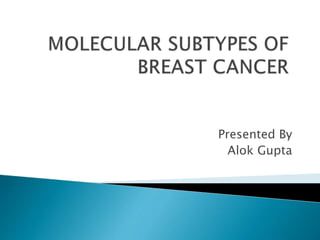
Molecular subtypes of breast cancer
- 2. Why molecular subtypes need need to be characterized ? How is molecular characterization done ? What is the molecular classification ? Prognostic relevance of molecular classification ? Predictive relevance of molecular classification ?
- 3. CHALLENGE- Despite surgery, cytotoxic chemotherapy, hormonal therapy, and/or regional radiotherapy, ~ 30% of patients will eventually experience disease recurrence The biologic reasons for recurrence and resistance to treatment are poorly understood PREDICT CHANCES OF RELAPSE
- 4. Histologic subtype Axillary lymph node status Tumor size Grade Age Comorbidities
- 5. IS THIS ENOUGH IN 21ST CENTURY??
- 6. Historically, breast cancers were divided into hormone receptor positive and negative tumours. Up to half of all hormone receptor positive breast cancers do not respond to endocrine treatment at initial presentation (intrinsic resistance) or there is inevitable development of resistance over time (acquired resistance) Osborne CK. Tamoxifen in the treatment of breast cancer. N Engl J Med 1998; 339: 1609e18.
- 8. They characterized variation in gene expression patterns in a set of 65 surgical specimens of human breast tumours from 42 different individuals, using complementary DNA microarrays representing 8,102 human genes. 1. The tumours show great variation in their patterns of gene expression. 2. This variation is multidimensional; that is, many different sets of genes show mainly independent patterns of variation. 3. These patterns have a pervasive order reflecting relationships among the genes, relationships among the tumours and connections between specific genes and specific tumours.
- 10. Hierarchical cluster analysis using this ‘intrinsic gene list’ revealed (i) the division of the cluster dendrogram into oestrogen receptor (ER)-positive and ER-negative breast cancers. (ii) the existence of four molecular subtypes of breast cancer: luminal, normal breast-like, HER2 and basal-like (Perou et al., 2000).
- 11. The same group demonstrated that the ER-positive luminal group could be separated into at least 2 subgroups, luminal A and luminal B.
- 12. Different molecular subtypes were associated with distinct clinical outcomes (Sorlie et al., 2001). Prognostic relevance of molecular classification
- 15. In the past decade, microarray-based gene expression profiling has been extensively applied to the study of breast cancer. ◦ Metastatic propensity (Wang et al., 2005; van’t Veer et al., 2002; van de Vijver et al., 2002) ◦ To identify signatures associated with prognosis (Sotiriou et al., 2006; Wang et al., 2005; van’t Veer et al., 2002; van de Vijver et al., 2002) ◦ Response to therapy (Potti et al., 2006).
- 16. Express ER Most common. Luminal A possess a higher expression of the ER and oestrogen-associated genes ESR1, GATA3 and FOXA1 Do not express HER2/neu Ki-67 proliferation index- low Luminal A tumours are associated with a better prognosis
- 17. Express ER Variable HER2/neu expression Increased frequency of TP53 mutations Ki-67 proliferation index- high Luminal B tumours are associated with worse prognosis compared to Luminal A
- 18. Oxford Journals Medicine JNCI J Natl Cancer Inst Volume 101, Issue 10,2009 Pp. 736-750.
- 19. Hormone receptor (ER and PR) and HER2/neu receptor negative Expression of genes associated with myoepithelial cells: KRT5 (keratin 5), KRT17 (keratin 17), CNN1 (calponin 1), CAV1 (caveolin) and LAMB1 (laminin) Aggressive with a poorer disease-free and overall survival than the other breast cancer subtypes
- 21. Increased expression of genes located in the same region on chromosome 17q: human epidermal growth factor receptor 2, ERBB2, and growth factor receptor bound protein 7, GRB7 Associated with a high histological grade, low expression of ER and PR Poor clinical outcome.
- 22. Goldhirsch et al. Ann Oncol June 2011. St Gallen 2011
- 23. Identified by microarray-based gene expression analysis and unbiased hierarchical clustering Drawback: routine use of microarray analysis or genome sequencing is still cost prohibitive.
- 24. Evaluated the analytical validity, clinical validity and clinical utility of two approaches.
- 25. Weigel MT, Dowsett M. Endocrine Rel Cancer 2010
- 26. Goldhirsch et al. Ann Oncol June 2011. St Gallen 2011
- 28. clinicaloptions.com/oncology Translational Research 2012 Growth factor self-sufficiency Hanahan D, et al. Cell. 2000;100:57-70. Cancer Insensitivity to anti-growth signals Evading apoptosis Tissue invasion and metastasis Sustained angiogenesis Limitless replication potential Hallmarks of Malignancy
- 29. clinicaloptions.com/oncology Translational Research 2012 Growth factor self-sufficiency Hanahan D, et al. Cell. 2000;100:57-70. Cancer Insensitivity to antigrowth signals Evading apoptosis Tissue invasion and metastasis Sustained angiogenesis Limitless replication potential Trastuzumab, aromatase inhibitors, tamoxifen Taxanes Trastuzumab Standard Adjuvant Therapy in Breast Cancer
- 30. clinicaloptions.com/oncology Translational Research 2012 Growth factor self-sufficiency Cancer Insensitivity to antigrowth signalsEvading apoptosis Tissue invasion and metastasis Sustained angiogenesis Limitless replication potential Src inhibitors, PI3K/Akt inhibitors T-DM1, lapatinib Denosumab Anti-integrin therapies ASA Telomerase inhibitors PARP inhibitors Rb inhibitors Dichloroacetate Ramucirumab Bevacizumab Physical exercise Metformin Everolimus Entinostat Predictions for Adjuvant Therapy in future
- 31. clinicaloptions.com/oncology Translational Research 2012 July 1, 2031 Ultigenomics has determined your patient’s T2N1 primary breast cancer has the following phenotype, and intervention is recommended: Tumor – PI3K-activating mutation: PiKtrimicin – HER2 pathway activation: T-DM1 – Telomerase activation: Tipglu This will reduce your pt’s estimated 10-yr risk of recurrence from 63% to 4% Stroma – VEGFR pathway activation: ramucirumab – Bone tropism: denosumab
